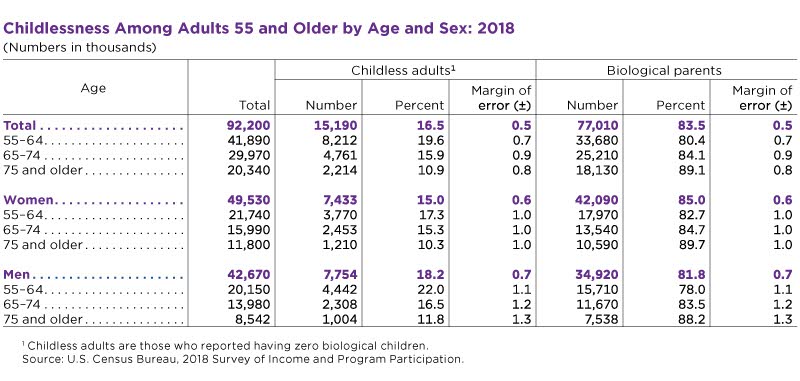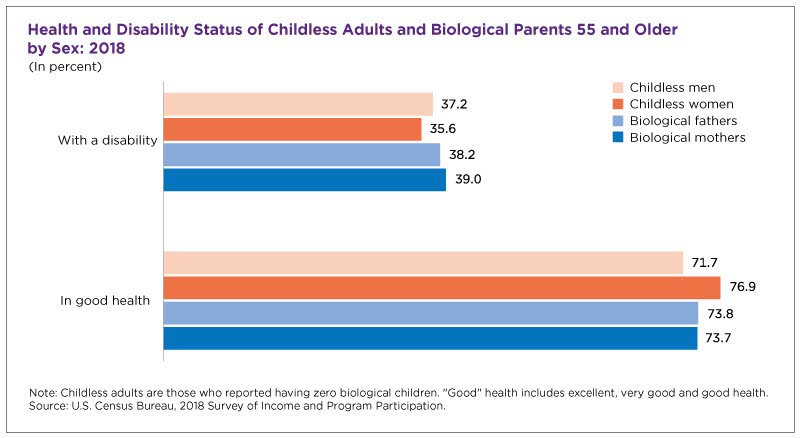Childless Older Adults More Educated, More Likely to Live Alone Than Older Parents
As the United States ages and the youngest baby boomers are now 58, the remarkable changes American families have gone through in recent decades highlight a new phenomenon: older adults without children.
Declines in marriage and fertility and increased cohabitation in the general population are starting to be reflected in the lives of aging adults.
Of the 92.2 million adults ages 55 and older in 2018, 15.2 million (16.5%) are childless, defined here as having no biological children.
Whether by choice or circumstance, many older adults do not have children. A new Census Bureau report, Childless Older Americans: 2018, provides much-needed information on these older adults and their wellbeing.
How Many Older Adults Are Childless?
Of the 92.2 million adults ages 55 and older in 2018, 15.2 million (16.5%) are childless, defined here as having no biological children.
Moreover, childlessness is more common among the younger cohort of older adults. This suggests that childless adults will make up an even greater share of the older adult population in the future.
How do Childless Older Adults Compare to Older Parents?
Childless adults have higher levels of personal net worth and educational attainment than older parents of biological children. They also are less likely to have a disability.
However, childless older adults are also more likely than parents to receive financial support from friends or family and more likely to be in poverty.
This suggests that the childless older adult population is multifaceted, with a portion who are socioeconomically well-off and another who may be at greater risk of financial hardship.
Other differences emerge when we analyze older childless women and men separately:
- Childless women have higher median personal net worth ($173,800) than childless men ($132,500).
- Childless women are also more likely to consider themselves in good health (77%), compared to 72% of childless men.
Who Supports Older Childless Adults?
While we do not have direct measures of caregiving, we use the detailed relationship information collected for all household members to identify potential sources of support within their household.
Childless older adults have fewer sources of potential support within their households: about 4 in 10 childless older adults live alone, compared to 2 in 10 parents.
Childless adults are also less likely to have gotten married and, therefore, less likely to be living with a spouse than are parents.
About 40% of childless adults are living with a spouse, compared to 63% of parents.
They are more likely than parents to be living with a cohabiting partner, but these relationships are still relatively uncommon among older adults: only 5% of childless adults and 3% of parents are cohabiting.
About 13% of older parents and 12% of older childless adults live with another type of relative such as an aunt/uncle, cousin, nephew, or parent.
It is important to remember that although childless adults have fewer sources of potential support within their households, those with more resources may be in a better position to obtain paid care than parents.
These data come from the 2018 Survey of Income and Program Participation (SIPP). The SIPP is a nationally representative longitudinal survey administered by the U.S. Census Bureau that provides comprehensive information on the dynamics of income, employment, household composition, and government program participation.
Because the SIPP provides detailed socioeconomic and relationship information about household members, along with well-being indicators and complete fertility histories of men and women, this report provides a holistic view of this growing population.
More information about SIPP data quality is available on the SIPP website's Technical Documentation page.
Note: This research was supported in part by the National Institute on Aging.
Tayelor Valerio is a survey statistician and Rose M. Kreider is a branch chief in the Census Bureau’s Social, Economic, and Housing Statistics Division.
Wan He is director of the Aging Research Program in the Census Bureau’s Population Division.
Story Ideas and Statistics
Stats for Stories
Stats for Stories
Stats for Stories
Facts for Features & Special Editions
Facts for Features & Special Editions









